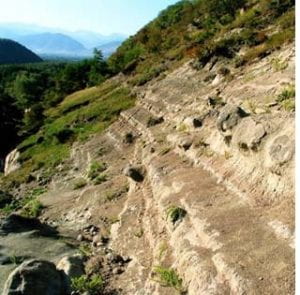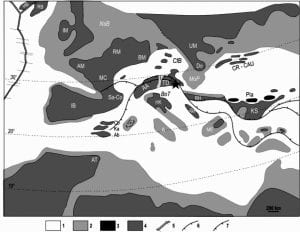Today Haţeg is a landlocked town in Romania, but 70 million years ago during the late Cretaceous it was an island within a shallow sea that covered much of today’s southern Europe. At almost 80,000 square kilometres, it was similar in size to the Caribbean island of Hispaniola (Csiki 2005). It was formed by uplift caused by the closing of the Tethys Ocean when the African and Eurasian plates collided, a collision which is also responsible for mountain chains in both Southern Europe and North Africa. The plate movements continue today, as Africa pushes north.
The Densus-Ciula and Sânpetru Rock Formations
 Left: Figure 1. Lithological sequence of fossiliferous sites near Sânpetru, the type locality of Nopcsa’s “Sânpetru sandstone”, from where most of the specimens he collected came.
Left: Figure 1. Lithological sequence of fossiliferous sites near Sânpetru, the type locality of Nopcsa’s “Sânpetru sandstone”, from where most of the specimens he collected came.
The sediments that once formed Haţeg island are included in the Densus-Ciula and Sânpetru formations. These contain a wealth of fossil remains, including those of the famous dwarf dinosaurs that inspired Franz Nopcsa’s theory of Insular Dwarfism. These formations are roughly the same age (Csiki et al. 2008), Maastrichtian (65.5-70.6 Ma) of the Late Cretaceous, and were laid down in similar environments of lakes and rivers (Therrien 2006).
Outcropping mainly in the Râul Mare and Sibisel valleys is the 2.5 km thick Sânpetru formation, which historically has been divided into two members based on lithological differences: the lower member consists of red and grey-green mudstones and pyroclastic material; the upper member lacks red mudstones and includes numerous conglomerate beds (Nopcsa 1905; Grigorescu 1983, 1992; Weishampel et al. 1991). There has been discussion about whether this division extends throughout the formation or just in the Sibisel Valley (Therrien 2006).
The Densus-Ciula formation in the north-west of the Haţeg basin is almost 4 km thick and is divided into three members based on lithological differences: the lowest consists of a volcanic/ sedimentary sequence interspersed with lake deposited lime-muds (lacustrine marls); the middle comprises matrix-supported conglomerates, sandstones, red, brown, and green-grey mudstones and an abundance of fossils; and the topmost member is distinguished by being both poor in fossils and volcanic sediments. The middle member of this formation is most famous for its rich fossils , including dinosaur bones and eggs (Grigorescu et al. 1990; Grigorescu & Csiki 2008), mollusks and plants (Antonescu et al. 1983) and microvertebrates (Grigorescu et al. 1999), including lissamphibians and squamates (Folie and Codrea, 2005), small theropods (Csiki and Grigorescu 1998), pterosaurs (Jianu et al. 1997; Buffetaut et al. 2002), and mammals (Grigorescu et al. 1985; Csiki and Grigorescu 2000).
The fossil beds of Haţeg are impoverished in dinosaurs, with 13 species from the Sânpetru Formation and 10 from the Densus-Ciula Formation, compared more than 30 or 40 species in the Late Cretaceous Hell Creek and Lance formations of North America and the Nemegt Formation of Mongolia. The European Late Cretaceous dinosaurian faunas are also impoverished in ecological types and major clades; missing groups include large tetanuran theropods (including tyrannosaurs), ankylosaurids, pachycephalosaurs, and ceratopsians. The Haţeg faunas show closest similarities to Late Cretaceous faunas from Gosau in Austria, southern France, and Spain (Holtz et al., 2004) as well as Hungary (Ösi and Rabi 2006). The reduced diversity of European dinosaurs reflects that all these sites were islands in the Late Cretaceous (Fig. 2).
 Figure 2. Palaeogeographic map of the Mediterranean sector of Tethys during the Maastrichtian stage of the Late Cretaceous, showing the location of Haţeg. Palaeolatitude revised based on Panaiotu and Panaiotu (2002).
Figure 2. Palaeogeographic map of the Mediterranean sector of Tethys during the Maastrichtian stage of the Late Cretaceous, showing the location of Haţeg. Palaeolatitude revised based on Panaiotu and Panaiotu (2002).
Abbreviations: A – Apulia; AA – Austro-Alpine Domain; Ab – Alboran Block; ACP – Apennine Carbonate Platform; AM – Armorican Massif; AT – Atlas; BM – Bohemian Massif; BoT – Bosnian Trough; Cb – Calabrian Block; CfB– Carpathian Flysch Basin; CR-CAU – Crimea-Caucasus; Do – Dobrogea; HB – Hatton Bank; HK – High Karst (Dinaric Carbonate Platform); IB – Iberia; IM – Irish Massif; Ka – Kabylia; KS – Kirshehir; MC – Massif Central; ME– Menderes; MoP – Moesian Platform; NsB – North Sea Basin; PIa – Pontides Island arc; RB – Rockall Bank; RH – Rhodope Massif; RM – Rhenish Massif; Sa-Co – Sardinian-Corsican Block; SP – Serbo-Pelagonian Massif; TD – Tisia-Dacia Block (the position of “Haţeg Island” is marked by a black star); UM – Ukrainian Massif; 1, the western boundary of Tisia-Dacia, as marked by the Maramures-Szolnok Trough and the Mid-Hungarian Line.
Legend: 1, deepmarine basins (pelagic carbonates, flysch); 2, shallow-marine basins (mainly siliciclastic and carbonate shelf deposits); 3, island arc; 4, emergent land; 5, active speading ridge; 6, thrust; 7, subduction.
Environment and Geography
Palaeogeographic reconstructions of Southern Europe during the Maastrichtian (Fig. 2) and palaeomagnetic analyses of sedimentary deposits (Patrascu and Panaiotu 1990; Panaiotu and Panaiotu 2002) have placed Haţeg island at a latitude between 20 and 30 degrees North, similar to that of the islands of the Caribbean today.
Based upon the study of paleosols (fossilised soils) the climate is thought to have been sub-tropical with distinct wet and dry seasons (Van Itterbeeck et al. 2004), carbon isotopes indicate “dry woodland” conditions (Bojar et al., 2005), and oxygen isotopes suggests a mean annual temperature of about 20-25 °C. Rainfall estimates differ according to whether they are based upon plant fossils or palaeosols. Palaeosols indicate that the climate had seasonal precipitation of less than 1000 mm/year, with greater evapotranspiration than precipitation and a fluctuating water table (Therrien, 2005). Fossil plants suggest mean rainfall of 1300-2500 mm/year (Pop and Petrescu, 1983). This difference may be explained by the ability of tropical plants to live in warm, monsoonal climates if they have access to sufficient water during the dry seasons to satisfy their metabolic needs, and so the palaeobotanical value was perhaps an overestimate (Therrien, 2005).
Haţeg – Island?
Although Nopcsa (1914) suggested that Haţeg had been an island, this was based largely on the fact the dinosaurs showed dwarfing. Geological evidence for this came later.
The size of Haţeg island has been debated, with estimates ranging 7500 to 200,000 square kilometres. The island of Haţeg would have been larger than just the Haţeg area today, as it would have included areas with no deposition; this puts the size of the island at 80,000 square kilometres (Csiki 2005).
Palaeogeographic reconstructions of Late Cretaceous eastern and southern Europe (Fig. 2) show an archipelago of tropical islands. Haţeg island would have been 200-300km away from the nearest mainlands in all directions. This isolation is confirmed by marine sediment deposits surrounding the Haţeg site.
Literature cited
- Antonescu, E., Lupu, D., and Lupu, M. 1983. Correlation palinologique du Crétacé terminal du sud-est des Monts Metaliferi et des depressions de Haţeg et de Rusca Montana. Annales de l’Institut de Géologie et Géophysique 59, 71-77.
- Benton, M.J., Csiki, Z., Grigorescu, D., Redelstorff, R., Sander, P.M., Stein, K., and Weishampel, D.B. 2010. Dinosaurs and the island rule: The dwarfed dinosaurs from Hațeg Island. Palaeogeography, Palaeoclimatology, Palaeoecology 293, 438-454. pdf.
- Bojar, A.V., Grigorescu, D., Ottner, F., and Csiki, Z. 2005. Palaeoenvironmental interpretation of dinosaur- and mammal-bearing continental Maastrichtian deposits, Haţeg basin, Romania. Geological Quarterly 49, 205-222.
- Buffetaut, E., Grigorescu, D., and Csiki, Z. 2002. A new giant pterosaur with a robust skull from the latest Cretaceous of Romania. Naturwissenschaften 89, 180-184.
- Csiki, Z., Grigorescu, D., 1998. Small theropods of the Late Cretaceous of the Haþeg Basin (Western Romania) – an unexpected diversity at the top of the food chain. Oryctos 1, 87-104.
- Csiki, Z. and Grigorescu, D. 2000. Teeth of multituberculate mammals from the Late Cretaceous of Romania. Acta Palaeontologica Polonica 45, 85-90.
- Csiki, Z. 2005. Sistematica si tafonomia microvertebratelor si dinosaurilor saurischieni din Maastrichtianul Bazinului Hațeg. Unpubl. Ph.D. thesis, University of Bucharest, 541 pp.
- Csiki, Z., Ionescu, A., and Grigorescu, D. 2008. The Budurone microvertebrate fossil site from the Maastrichtian of the Haţeg Basin – flora, fauna, taphonomy and paleoenvironment. Acta Palaeontologica Romaniae 6, 49-66.
- Folie, A. and Codrea, V. 2005. New lissamphibians and squamates from the Maastrichtian of Haţeg Basin, Romania. Acta Palaeontologica Polonica 50, 57-71.
- Grigorescu, D., 1983. A stratigraphic, taphonomic and paleoecologic approach to a “forgotten land”: the dinosaur-bearing deposits of the Haþeg Basin (Transylvania-Romania). Acta Palaeontologica Polonica 28, 103-121.
- Grigorescu, D. 1992. Nonmarine Cretaceous formations of Romania. In: Mateer, N.J., Chen, P.J. (Eds.), Aspects of Nonmarine Cretaceous Geology. China Ocean Press, Beijing, pp. 142-164.
- Grigorescu, D. 2010. The Latest Cretaceous fauna with dinosaurs and mammals from the Haţeg Basin – a historical overview. Palaeogeography, Palaeoclimatology, Palaeoecology 293, 271-282.
- Grigorescu, D. and Csiki, Z. 2008. A new site with megaloolithid egg remains in the Maastrichtian of the Haţeg basin. Acta Palaeontologica Romaniae 6, 115-121.
- Grigorescu, D., Hartenberger, J.-L., Rãdulescu, C., Samson, P., and Sudre, J. 1985. Découverte de mammifères et de dinosaures dans le Crétacé supérieur de Pui (Roumanie). Comptes rendus de l’Académie des Sciences de Paris 301, 1365-1368.
- Grigorescu, D., Seclãman, M., Norman, D.B., and Weishampel, D.B. 1990. Dinosaur eggs from Romania. Nature 346, 417.
- Grigorescu, D., Venczel, M., Csiki, Z., and Limberea, R. 1999. New latest Cretaceous microvertebrate fossil assemblages from the Haţeg Basin (Romania). Geologie en Mijnbouw 98, 310-314.
- Jianu, C.-M., Weishampel, D.B., and Stiucã, E., 1997. Old and new pterosaur material from the Haþeg Basin (Late Cretaceous) of western Romania and comments about pterosaur diversity in the Late Cretaceous of Europe. Second European Workshop on Vertebrate Palaeontology (Espéraza – Quillan), Abstracts.
- Holtz, T.R., Chapman, R.E., and Lamanna, M.C. 2004. Mesozoic biogeography of Dinosauria, In: Weishampel, D.B., Dodson, P., Osmólska, H. (Eds.), The Dinosauria, 2nd edn. University of California Press, Berkeley, California, pp. 627-642.
- Nopcsa, F. 1905. Zur Geologie der Gegend zwischen Gyulafehérvái, Déva, Ruszkabánya und der rümanischen Landesgrenze. Mitteilungen aus dem Jahrbuch der Ungarischen geologischen Anstalt 14, 91-279.
- Nopcsa, F. 1914. Über das Vorkommen der Dinosaurier in Siebenbürgen. Verhandlungen der zoologische-botanischen Gesellschaft, Wien 54, 12-14.
- Ösi, A. and Rabi, M. 2006. The Late Cretaceous continental vertebrate fauna from the Bakony Mountains II: crocodiles, dinosaurs (Theropoda, Aves, Ornithischia), pterosaurs. Földtani Közlöny 136 (4), 503-526. In Hungarian.
- Pãtrascu, S., Seclãman, M., and Panaiotu, C. 1990. Tectonic implications resulted from paleomagnetic researches on Upper Cretaceous continental deposits of the Haţeg Basin (Romania). In: Grigorescu, D., Avram, E. (Eds.), Abstracts Volume, International Meeting of the IGCP Projects 245 (Non-marine Cretaceous Correlation) and 262 (Tethyan Cretaceous Correlation). Bucharest, p. 23.
- Panaiotu, C. and Panaiotu, C. 2002. Paleomagnetic studies. In: Grigorescu, D., Csiki, Z. (Eds.), 7th European Workshop on Vertebrate Palaeontology, Abstracts Volume and Excursions Field Guide. Sibiu, p. 59.
- Therrien, F. 2005. Paleoenvironments of the latest Cretaceous (Maastrichtian) dinosaurs of Romania: insights from fluvial deposits and paleosols of the Transylvanian and Haþeg basins. Palaeogeography, Palaeoclimatology, Palaeoecology 218, 15-56.
- Therrien, F. 2006. Depositional environments and fluvial system changes in the dinosaur-bearing Sânpetru Formation (Late Cretaceous, Romania): post-orogenic sedimentation in an active extensional basin. Sedimentary Geology 192, 183-205
- Van Itterbeeck, J., Sasaran, E., Codrea, V., Sasaran, L., and Bultynck, P. 2004. Sedimentology of the Upper Cretaceous mammal- and dinosaur-bearing sites along the Râul Mare and Bãrbat rivers, Haþeg Basin, Romania. Cretaceous Research 25, 517-530.
- Weishampel, D.B., Grigorescu, D., and Norman, D.B. 1991. The dinosaurs of Transylvania. National Geographic Research 7, 196-215.

